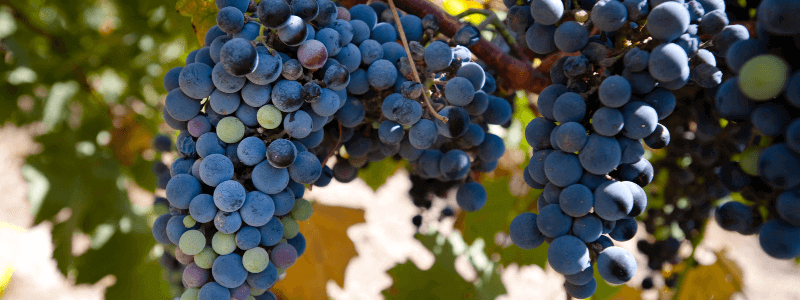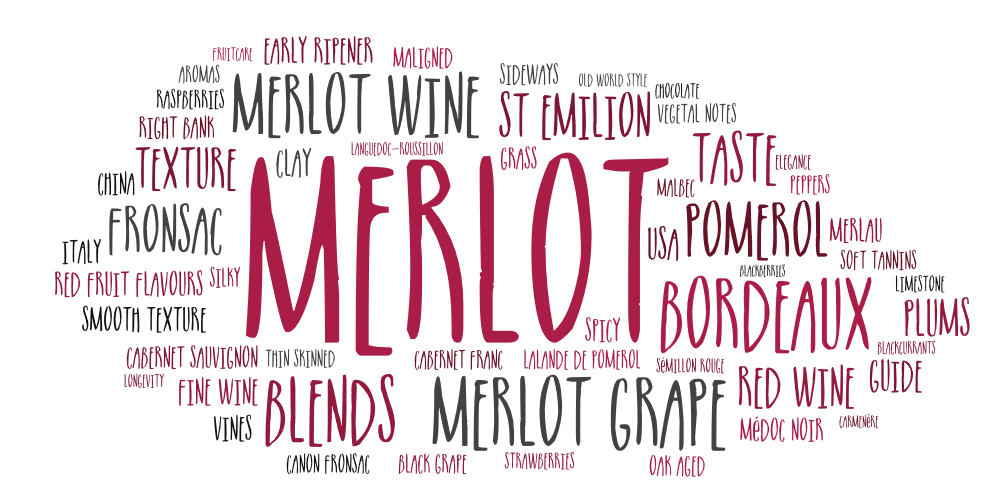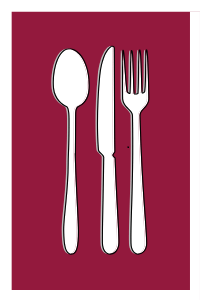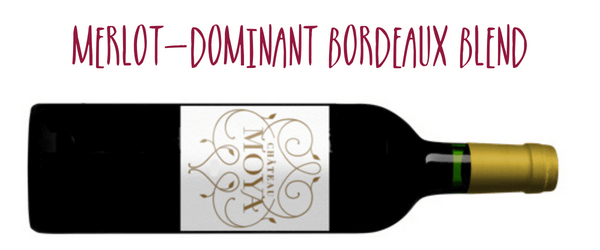No products in the basket.

A guide to the Merlot grape and where it is grown, the characteristics of Merlot wine and what it tastes like plus what to eat with Merlot. Often in the shadow of Cabernet Sauvignon, with which it is frequently blended, most famously in Bordeaux, Merlot has somehow acquired a reputation for being inferior, its reputation not helped by the 2004 film Sideways in which Merlot was shunned by one of the main characters simply because his ex-wife liked it. But it is the second most widely-grown grape in the world so there must be something to like about this maligned grape, Merlot, and its wines, as we will discover.
Merlot is a black grape variety that ripens earlier than many other varieties and is therefore often used as an ‘insurance’ in blends, should other grapes not have chance to ripen fully due to poor weather e.g. in Bordeaux where a larger percentage of Merlot may be used in wines if the later-ripening Cabernet Sauvignon has not seen enough sunshine and warmth. On the downside, Merlot buds early which makes it susceptible to frost and it is thin-skinned which makes it susceptible to rot and mildew so in very cold and/ or damp years there is a risk of low or even no yields.
But on the whole Merlot is considered relatively easy to grow and that means that, despite the fact that it plays a significant role in many fine wines such as Pomerol and St Emilion in Bordeaux, Merlot can also be found in many more commercial-style wines of varying quality across the globe.
The name Merlot is thought to derive from the French word for blackbird, ‘merle’, and there are differing views as to whether it is because its skin colour resembles the colour of a blackbird’s feathers or whether it is because that species is particularly partial to the sweet grapes. Other names for Merlot include Merlot Noir, Merlau, Médoc Noir and Sémillon Rouge.

France is home to circa 40% of the world’s Merlot vines and about half of those are in Bordeaux, from where the grape originates. Often seen as a support grape to Cabernet Sauvignon in that region, there is in fact more Merlot than Cabernet Sauvignon planted there. Merlot is traditionally the more dominant grape variety in the Bordeaux blends of the right bank areas of Bordeaux (north of the Dordogne river) such as St Emilion, Fronsac and Canon-Fronsac, Pomerol and Lalande de Pomerol as it is well-suited to the limestone and clay soils there. However Merlot is added in seemingly ever-increasing quantities to wines of the traditionally Cabernet Sauvignon-dominant left bank areas of the Médoc and Haut Médoc (south of the Gironde river), especially in vineyards with less of the traditional left bank gravel-based soils.
The other main French region that has Merlot plantings is the Languedoc-Roussillon region which produces mainly blends of IGP wines, previously known as vins de pays, of varying levels of quality. Following France in the rankings, Italy, the USA and China have the next largest vineyard areas dedicated to Merlot but these account for just 9%, 8% and 6% respectively.
When it comes to flavour, Merlot is a bit of a chameleon because firstly it is often blended with other grapes but secondly and perhaps most importantly its aromas and flavours can vary greatly depending upon a number of factors including the climate conditions in which the grape has grown, whether it has been picked early or late in the ripening season and whether it has been oak-aged or not and for how long. So Merlot can be quite hard to recognise.

Pure Merlot wine from cooler climate regions or from early-picked grapes is known for its classic red fruit flavours – raspberries, plums and even strawberries with some vegetal notes like peppers and even grass. These red-fruit flavoured Merlots are considered more old-world style; they generally have lower levels of tannin and alcohol but have good levels of acidity and a smooth texture. Note that if Merlot displays too many green flavours, it is likely that the grapes were picked a little too early or may not have really ripened fully.
When produced in warmer climate regions 100% Merlot wine will be bigger and bolder, often considered to be a more international style of Merlot. Fruit flavours may also include blackcurrants and blackberries, ripe plums with spicy notes, chocolate and even a touch of fruitcake. Alcohol is likely to be higher and the wine generally more full-bodied with soft tannins (given the thin skins).
In blends Merlot is valued for its natural sweetness – not that it is high in residual sugars but more that the fruit flavours are of sweet juicy ripe fruits – and for its softer, more approachable characteristics. In fact it is specifically paired with Cabernet Sauvignon in order to tone down some of Cabernet’s more austere qualities. Merlot-dominant wines age relatively well but are generally ready to drink much earlier than their Cabernet Sauvignon-dominant counterparts.

Merlot wines, whether a simple commercial style, a fresh, cooler climate, red-fruit style or a richer, spicier style, can of course be enjoyed on their own because of the soft tannins and smooth texture though you may enjoy the finer examples of Merlot after it has been in bottle at least three or four years. Which foods would complement Merlot – and vice versa – really depends upon which style of wine it is.
Easy-drinking, lighter, fruity Merlot pairs well with tomato-based sauces, pizza or chilli con carne. The more savoury style of Bordeaux Merlots or Merlot-dominant blends complements most red meats including game, mushrooms, truffles and roasted vegetables especially the more mature wines. The juicier, fuller-bodied style of Merlot make for a good match for steak, game, lamb especially when served rare, and duck.
But really you can’t go too wrong with Merlot. If in doubt, remember number 1 of my food and wine-matching tips – match the wine with the intensity of the food i.e. match heavier, more intensely flavoured wines with stronger-flavoured foods and lighter styles with more delicate flavours.
According to the University of Adelaide’s Database of Regional, National & Global Winegrape bearing areas, Merlot has grown in stature or at least in volume from 5th most-widely grown grape variety circa 20 years ago to second in the ranking (after Cabernet Sauvignon), so it is surely getting over its reputation for being an inferior wine. In fact its less tannic bite, its soft character, fruity flavours and readiness to drink earlier are all reasons to give Merlot a try.

If you are a fan of Cabernet Sauvignon, Cabernet Franc, Malbec or Carmenère, you will probably find Merlot a slightly softer, fruitier wine. Try one of the right bank Bordeaux wines such as St Emillion, Pomerol or Canon-Fronsac or one of the satellite appellations Castillon Cotes de Bordeaux or Lalande de Pomerol for some of the world’s best Merlots with complexity, elegance and silky smooth texture.
© 2014-2025 Wines with Attitude Ltd | VAT Reg. No. 181 2419 22 | Registered in England 08918466 | Fiveways, 57-59 Hatfield Road, Potters Bar, Herts, EN6 1HS